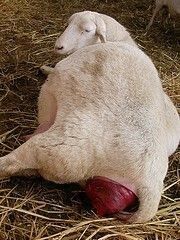Bearings in Ewes/Hoggets
Prevention only works once you know what causes bearings.
The ratio of the elements, Phosphorus – Potassium – Magnesium – Calcium and Sodium are what are termed as the electrolyte balance.
Muscle contraction is controlled by Calcium; muscle relaxation is controlled by Potassium. Sodium dilutes Potassium. Sphincter muscle strength relies on Magnesium; low Magnesium intakes will leave the muscles that control the squeezing function weakened. It is therefore not hard to understand that an imbalance in the ratios of these elements will have a detrimental effect on the ewe’s/hogget’s ability to retain her uterus.
Get these electrolyte ratios right and bearings in your ewes/hoggets will be minimised.
Here is an on-farm example of how the electrolyte balance works -
A farmer rang me with his story. This hogget had just given birth to twins, right by the gateway into the lane that runs to the woolshed. He thought he would do the hogget a favour and drift her and her lambs into the laneway, to give her an extra feed. A couple of days later as he was driving up the lane, the hogget ran in front of him and up the hill, she popped both bearings out as she ran in front of him.
So, what created this problem?
I asked the farmer “do you use that part of your laneway to empty your sheep out?” His answer was “yes and it’s also used to dry wet sheep for shearing”.
Now we have soil and pasture loaded up with high levels of Potassium from the dung and urine. At the same time the hogget is still growing her own skeleton, and has just grown two lambs, all of which take large quantities of Calcium for bone growth. Now that she has lambed there is a large requirement for Calcium to produce milk. Calcium controls muscle contraction and Potassium controls muscle relaxation. This hogget now has low levels of Calcium left for muscle contraction and she’s eating pastures that are very high in muscle relaxing Potassium.
The same scenario takes a slightly different course in pre-lambing ewes. But the effect is the same. Calcium has been utilised to grow lambs in the womb and right at the point of lambing, the spring flush of grass starts to kick off. The earliest stage of the spring flush is almost undetectable by observation. However, the very first mineral element that is taken up by pastures is Potassium. This high uptake of Potassium is made worse by low soil levels of Calcium and Magnesium. Once again, Calcium for contraction, and Potassium for relaxation. Remember prevention is the most profitable cure for bearings.
By carrying out a pasture test through Qlabs, we can measure your pastures electrolyte balance and formulate a mineral balancing mix that you can put out for your animals. The cost of the test is half of the monetary losses of one dead ewe. It really is that easy. Qlabs clients utilising our Fallain™ programmes have very few to no bearings.



